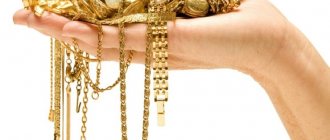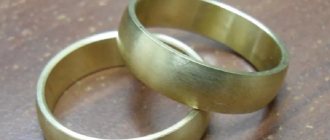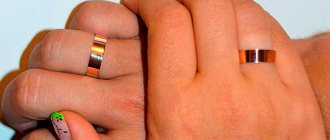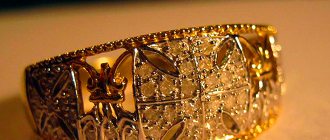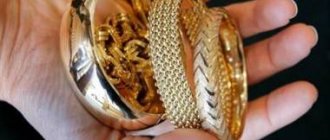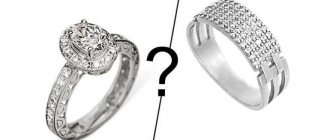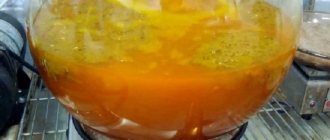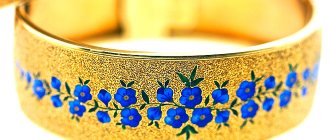Everyone wants to figure out whether a piece of jewelry is gold or gilded, or does not even have a hint of gold. After all, the desire to own this metal is strong in us. And no one wants to be deceived. Before you understand how to distinguish gold from gilding and different types of fakes, it is worth thinking about what you want to achieve by buying this or that gold jewelry.
It is possible that your goal is only to have a gold-appearing appearance. After all, the love for gold jewelry is ancient. We can say that it has been cultivated in us since childhood through fairy tales, feature films and documentaries. As we grow up, we ourselves begin to distinguish the social status of our interlocutor by the number and type of jewelry. And this is how we were brought up: the more gold we see, the higher we evaluate the position of our opponent.
Already in adulthood, we ourselves educate each other, encouraging us to compete in status things, including gold jewelry. And the desire to appear to have a higher status is understandable. This is what often pushes people to buy fakes at a bargain price.
Do you want to buy a gold ring or other jewelry, not only to emphasize your importance in appearance to your friends and colleagues, but also to gain self-confidence? Then, of course, it is necessary to understand the types of hallmarks on gold, and the options to distinguish where the gold is and where the gilding is. And the fact is that the jewelry is definitely not made of copper or other alloys.
Methods for determining gold and gilding
Determining where there is gold and where there is just gilding, or the absence of the precious metal even in minute quantities, is not so difficult. It is enough to use proven methods.
Before we tell you how to distinguish real gold from a fake, you should understand how it is marked. After all, if you buy a gold product in a well-known store, then you will not need to bother with checks. It will be enough to look at the labeling.
The designations accepted in Ukraine include the brand. It can be on the inside or outside of the decoration, depending on its type. The mark consists of a hallmark and a trident coat of arms. If you see such a print, and, as we have already said, you choose it in a trusted store, you can have no doubt about the authenticity of the jewelry.
However, do not forget that genuine gold jewelry can be of completely different purity. And they are also worth understanding.
The most common gold samples:
- 585 – first place in terms of presence on the jewelry market. Jewelers have identified an alloy containing 58.5 parts of gold per weight of the item as the most optimal option. This is the only way to ensure maximum durability and attractive appearance of gold. This hallmark is used in most jewelry around the world.
- 750 - second place. An alloy containing as many as 75 parts of gold is, of course, more expensive. Only such decoration cannot be considered durable. It can be made to order, and the wearer will be encouraged to wear the jewelry on special occasions. The 750 grade product is not suitable for daily wear. Accordingly, it is rarely found in specialized stores. If there are such decorations, then they are an order of magnitude smaller than the number of 585 samples.
- 375 - third place. The most inexpensive version of gold, which can, in principle, be considered gold and used in jewelry. Jewelry of this standard is rarely found in large stores. If there is, then in even smaller quantities than jewelry of 750 standard.
An addition to part of the gold, i.e. The ligature is an alloy of different metals. The 585 uses copper, palladium, nickel and silver. For 750, platinum is also added to the above. But in 375-carat gold jewelry the ligature contains only copper and silver.
What is gold plated jewelry?
The difference between pure gold and gold-plated jewelry has to do with the metal composition: while gold jewelry is made entirely of a gold alloy, gold-plated jewelry is made of a different metal that is simply coated with a thin film of gold.
The term “gilding” means that the product does not consist of gold, but is only covered with a layer of it on top.
Gold-plated jewelry of the same standard as gold is, of course, much cheaper. Since real gold is simply applied to the product, and is not part of it.
Gilt hallmarks
When you set out to buy a gold-plated ring or earrings, you should not think that there will be no mark. Even though such jewelry will only have gold plating, it must be marked. And they do this all over the world.
The test for silver with gilding may be familiar to you from some of your jewelry. But, unfortunately, with gold-plated products not everything is as simple as with gold. After all, they are much more common among jewelers and, accordingly, in stores.
There are three most common types of hallmarks on gold-plated products:
- Gold plated – the thinnest gold coating is applied using electrolysis.
- Gold filled – gold plating is fused onto any metal, most often silver. It differs from the product with the first sample in a thicker layer of gold.
- Gold soldered – very inexpensive products stand out with this gilding. After all, a breakdown with this designation speaks of a tin-lead inclusion.
It turns out that even if you want a gold-plated ring or something else, you will still be protected from counterfeiting if you buy the product in a specialized store. You should not think that hallmarks are placed on someone’s whim. The State Assay Office monitors manufacturers' compliance with all jewelry standards.
Is it possible to restore gilding on silver?
If your earrings, bracelet or ring are frayed and some areas of the gilding have peeled off, they can be restored to their beautiful appearance. To do this, you need to reapply the gold plating and contact a workshop. You need to contact an experienced specialist to ensure that the product lasts at least a year. Keep in mind that not every jeweler has professional equipment for gilding. Sometimes the cost of plating jewelry with gold is higher than the price of finished silver jewelry.
Before applying gilding to the jewelry again, you need to calculate whether it will be profitable and get acquainted with the prices in several workshops.
Methods for calculating counterfeit gold
Considering in a store what type of jewelry you want is the easiest way to distinguish gold from a fake. But if you bought jewelry from a store you've never heard of, or it was just given to you as a gift, then you need to know how else you can spot a fake.
Some proven ways to identify gold at home. They do not give a 100% guarantee, but in some cases they will eliminate doubts.
- Bite the decoration. All common grades assigned to gold indicate the content of the yellow metal itself. And there is not a single common test that would make jewelry as hard as diamond. The inherent softness of gold still remains. Therefore, you can easily distinguish the marks of your teeth if the jewelry is truly gold.
The exception is a fake with the addition of lead. There will also be a mark on it.
- Attach a magnet. Gold is a non-magnetic material, as is the ligature used in making jewelry. Accordingly, it is useless to apply a magnet to gold - it will not stick.
Counterfeits often use copper, lead and other metals used in the alloy. They are also not magnetic.
- Dip in vinegar or alcohol. Nothing will happen to gold, but metal similar to it will darken.
There is no catch in this method. No other cheap metal can withstand household acid or rubbing alcohol.
- Scratch. Should only be used as a last resort. After all, no matter what the jewelry turns out to be, you will still want to continue wearing it. Therefore, it is worth scraping where it will not be noticeable.
There is no way to hide metal under gold. If another metal is visible in the place of the scratch, then you definitely have at least a gilded piece of jewelry, and at most, the top layer is not even gilded.
- Heating. A little dangerous way. It is worth arming yourself with a special tool so as not to get burned. If after this procedure there are no stains on the gold, it is genuine.
The catch may be in the sample. Nobody canceled the deception with a fake brand. After all, 750 is more expensive.
Methods by which one could check a fake if the product is plated with gold are not relevant. Few people will counterfeit it because of the cost of the product. Passing off the same copper as gold-plated jewelry is simply not profitable and happens very rarely.
With gilding, jewelry can act as a counterfeit product in gold. Then all the methods described above will work.
How to extend the life of gilded silver
In order for gold-plated products to retain their original appearance for as long as possible, you must follow these tips and properly care for them:
- before going to the bathhouse, sauna or gym, remove jewelry from your body;
- avoid intense friction;
- Do not store accessories in cardboard boxes that emit sulfur;
- do not allow contact with household chemicals;
- Remove rings while cleaning and wear gloves.
These tips will help ensure that your jewelry lasts for a long time. Do not forget about the correct storage system for gold-plated jewelry. To do this, you need to get a small box, which will be lined with soft fabric. If there are few accessories, they can be stored in small velvet bags.
In order to extend the life of a solid silver plated item, you will need the following ingredients:
- Vinegar. The essence is used for severe contamination. You cannot use a 100% product; 9% vinegar is suitable for cleaning. For a liter of water, 30 ml of table vinegar is enough. Place the jewelry in the resulting mixture and leave for 25 minutes. After this, the accessory must be washed in running water.
- Ethanol. This method is great for regularly wiping away dust, sweat and dirt. You need to use cotton pads or a soft, lint-free cloth moistened with the product.
- Beer. This ingredient is used to restore shine to a product. First you need to prepare 1 glass of the drink and keep the accessory in it for no more than 20 minutes. After this procedure, gold-plated items should be washed and wiped with a suede cloth.
- Ammonia. This treatment option is suitable for gentle cleaning of products that have become covered with a green coating. You need to heat a liter of water, add 10 ml. dishwashing detergent and 5-6 drops of ammonia. The next step is to immerse the contaminated items in the solution for half an hour, rinse thoroughly under running water and wipe dry with suede.
How not to be deceived by gilding
The gold layer on the base metal is always small. Therefore, during any experiment with gilding, technical or chemical, the bottom layer will always give itself away. However, this will not show whether the metal in front of you is gold or another metal.
If you really want to understand whether your jewelry is gold-plated or just has the appropriate color, then only a jeweler can help you. In order not to spoil the color of the jewelry with reagents, most often craftsmen make an invisible puncture. This is how they calculate the thickness of the gilding. And to determine whether this coating can even be called gold, they can scrape off a little of the top layer in an inconspicuous place and separately treat this powder with chemicals.
Which products hold gold plating longer?
Gold plating adheres best to jewelry with a thick layer of sputtering. Not only the durability of the accessory, but also its cost depends on this. The top layer of spraying ranges from 2 to 15 microns. But it is difficult to determine this parameter on the finished product; you need to study the product certificates before purchasing. Therefore, it is better to choose jewelry that will rarely come into contact with human skin - for example, earrings.
Gold plating wears off most quickly from rings, bracelets and chains, and lasts the longest on pendants, brooches and earrings. To preserve the gilding, the jewelry is coated with a protective layer and is wear-resistant.
Durability.
The durability of a gold-plated item depends on the thickness of its gold layer and its karat (lower karat numbers indicate that the alloy contains some soft pure gold, which means it is more reliable and wear-resistant).
Some jewelry can be used perfectly for 20-30 years. But generally, they last 3-8 years before the gold layer starts to wear off.
Although, the service life of such jewelry directly depends on the intensity of use. If you wear jewelry, for example, a ring every day, it is unlikely to last more than five years, but if you wear it once a year, you can wear it for the rest of your life.
Markings.
Gold jewelry is usually marked only with the carat number. For example, an 18-karat piece must have a marking such as “18K,” “18KT,” or “18KR.”
In Europe, you may see karats expressed as a decimal, percentage, or thousandth: 18 karat jewelry may be marked as "0.75" or "750" since 18 karats implies 75% precious metal content (18 divided by 24, which is the maximum number of carats possible).
Gold-plated jewelry must also be marked with the karat number.
But they usually have additional letters and numbers on the markings that indicate that they are not made of pure gold. The most common identifier for such products is the “GF” mark after the carat number.
For example, the marking "1/10 22K GF" indicates that it is gold plated and its gold layer is made of 22 karat gold; The fraction "1/10" in front of the carat number means that one tenth of the weight of the item is gold.
Sometimes, instead of "GF" you may see the sign "RGP", which stands for "rolled gold". This type of jewelry is made in the same way as false gold, but the gold layer is much thinner.
Note: Although a simple karat number stamp such as "14K" without any additional letters should indicate that it is solid gold, some suppliers may sell gold plated jewelry that is not marked with the letters "GF". Examining the markings is one of the quickest ways to determine what your jewelry is made of.
Another most common stamp is GP, which stands for "gold plated."
You can also see GEP, which means gold plated with a layer of metal.
HGE ("heavy galvanized") is another marking that indicates gold plating (you may also see the designation HGP, which has the same meaning).
Please note that the absence of such markings does not mean that your jewelry is pure gold: it may simply not be printed.
Magnet check.
Another way to check what metals your jewelry contains is to use a magnet. Since gold is not magnetic and your jewelry is attracted to a magnet, some of it must contain some other metal.
This test, however, is inconclusive for several reasons.
First, while your jewelry's reaction to a magnet indicates that the item is not exclusively gold, it does not necessarily mean it is gold-plated—it could be a gold alloy that is low in purity and contains a magnetic metal.
Second, coated jewelry may not be attracted to a magnet if its base metal is non-magnetic.
The magnetic test is not useless, however: using it in combination with other tests can give you some clues as to what your jewelry is made of.
How are they made?
The basis of the decoration is any suitable metal, usually copper or nickel.
A piece of jewelry may appear to be solid gold, but may actually be false gold.
False gold is made by wrapping a very thin sheet of pure gold around a base made of another material such as nickel or copper. Heat is used to adhere the coating to the base.
False gold items are similar to gold plated items in that they are not solid gold; however, gold plated jewelry has a much thinner plating.
Solid gold jewelry, in contrast, is made entirely of one material—usually an alloy containing gold mixed with other metals to make the alloy heavier and stronger.
Pros and cons of gilding
For many centuries, gold items were an indicator of wealth, power, and status of the nobility. Gold plating was applied to household items and dishes. The material was used to decorate furniture and buildings outside and inside. Based on this, the advantages are:
- reasonable price of the product;
- dishes and other products look as luxurious as possible;
- the golden layer can be restored.
Disadvantages of gilding:
- the coating is short-lived;
- the gilding gradually wears off;
- The service life of the coated item is influenced by the layer and gold plating sample.
Edible gold leaf has a simple composition: 96% gold and 4% silver
Color as an indicator.
The color of a piece of jewelry can also be used as a clue as to whether it is solid gold or plated.
Gold-plated jewelry is sometimes plated with 24 karats of gold. Gold items, on the other hand, are not made of pure gold because it is too soft; instead, they are made from a gold alloy that contains metals that give it hardness.
So if your jewelry has an intense yellow color, similar to pure gold, and is relatively cheap (or priced close to the cost of 10 or 14 karat pieces), then it may be gold plated.
You can also inspect the surface and see if its tone is uniform throughout or if there is a change in color somewhere: if the gold coating has worn off in some places, then the base metal will be visible.

